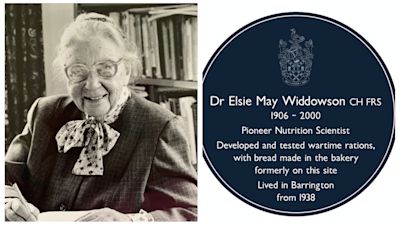Blue Plaque unveiled for pioneering nutritionist behind wartime rationing

A Blue Plaque's been unveiled in South Cambridgeshire for a pioneering scientist who was the mastermind behind wartime rationing in Britain.
Elsie Widdowson is credited as one of the outstanding scientists of the twentieth Century for her work with nutrition and someone who helped advance the cause of women in science.
Elsie lived in the South Cambridgeshire village of Barrington for sixty years.
The plaque is on the wall of the former bakery in the village, which once made the bread for all of Elsie's studies. The bakery is now a house, next to the village shop.
The idea for the plaque came from Dr Margaret Ashwell OBE who was a friend of Elsie's as well as a colleague and her biographer.
History of Elsie Widdowson
Elsie gained her BSc and PhD at Imperial College, London, in chemistry and in a pivotal moment in 1933 she met Dr Robert McCance in the kitchens of Kings College Hospital, London. She was brave enough to tell him that his values for the sugars in apples were too low.
The pair moved to the Department of Experimental Medicine in Cambridge in 1938. During the first months of the war in 1939, they felt they must do something to further the war effort.
Their studies showed that good health could be supported by a very restricted diet. They were also the first to advocate for the fortification of food, specifically bread, with vitamins and minerals such as calcium.
Their work became the basis for formulating the wartime rationing of Britain during World War II.
Elsie was extremely proud to be awarded her Fellowship of the Royal Society in 1976, closely followed by her CBE in 1979.
She became one of Britain's most famous scientists when she was made a Companion of Honour in 1993.
Living in her thatched cottage on the River Cam in Barrington, Cambridgeshire with her cats for company, growing fruit and vegetables, she remained scientifically productive until her death, at the age of 93, in 2000.